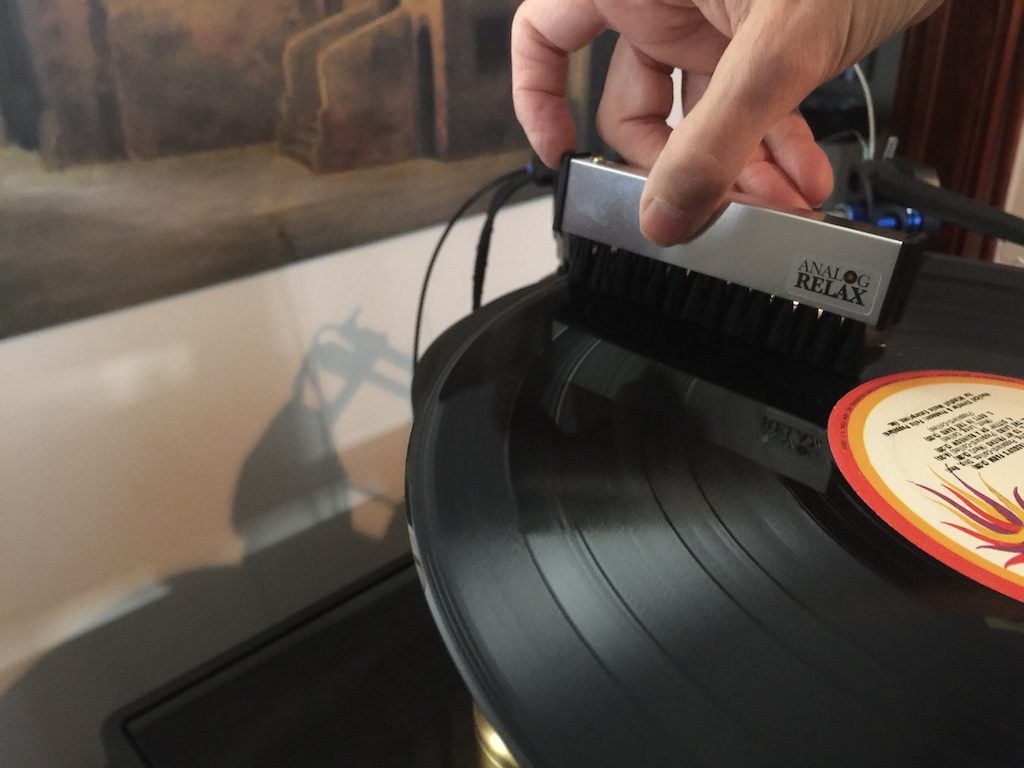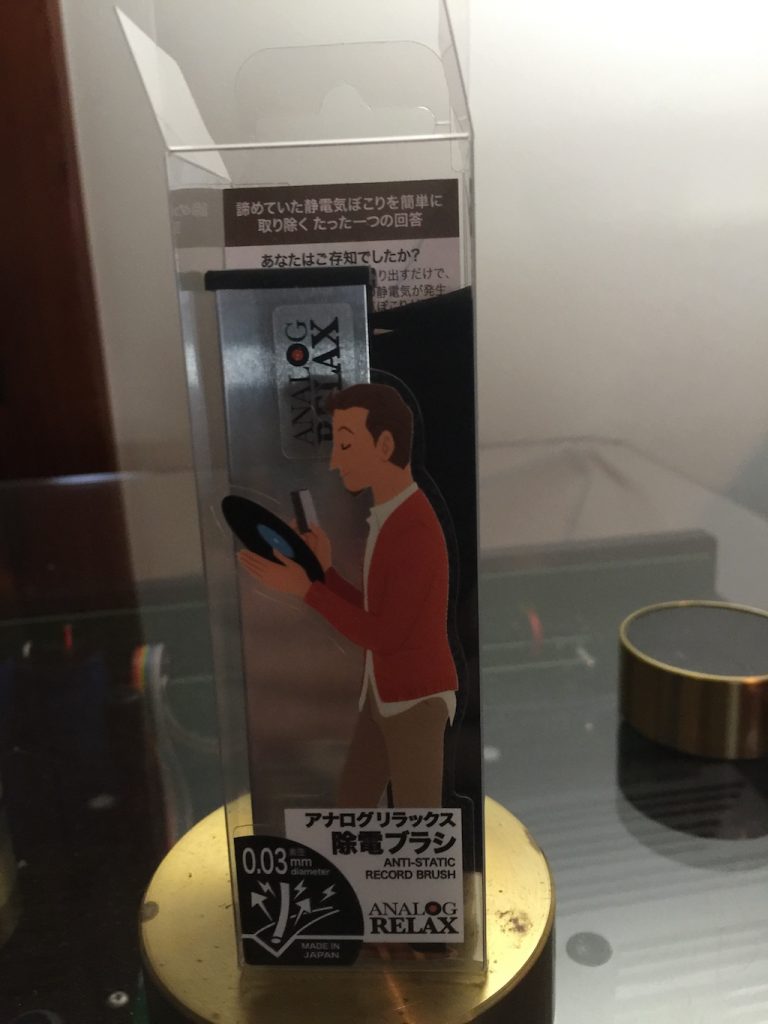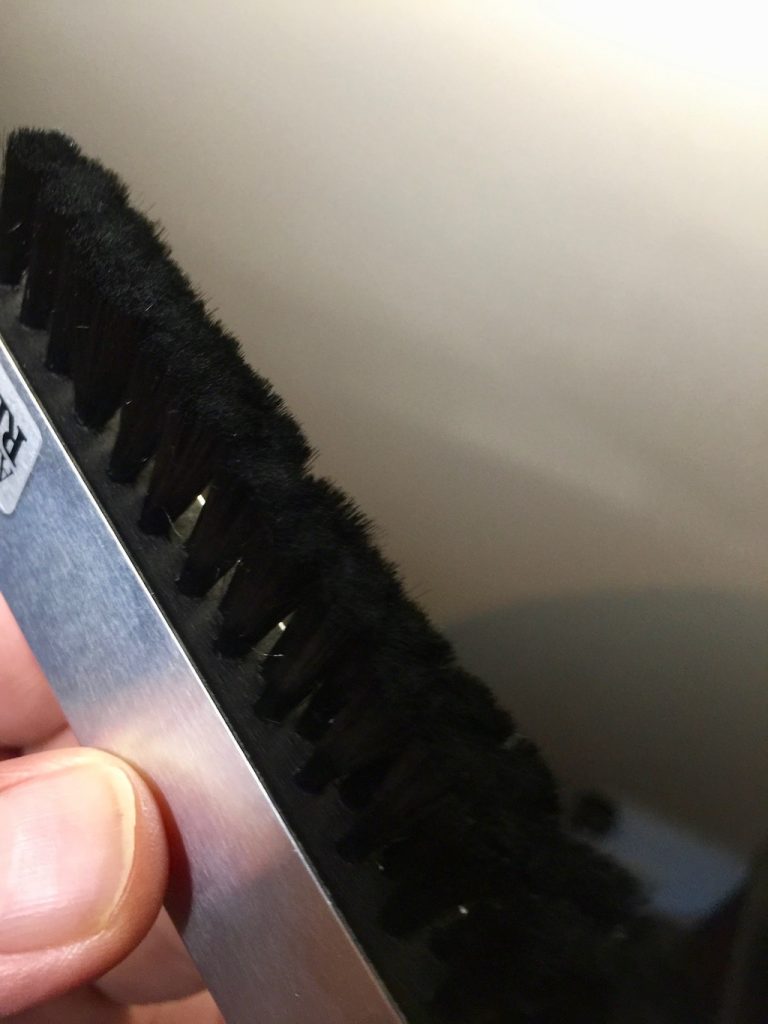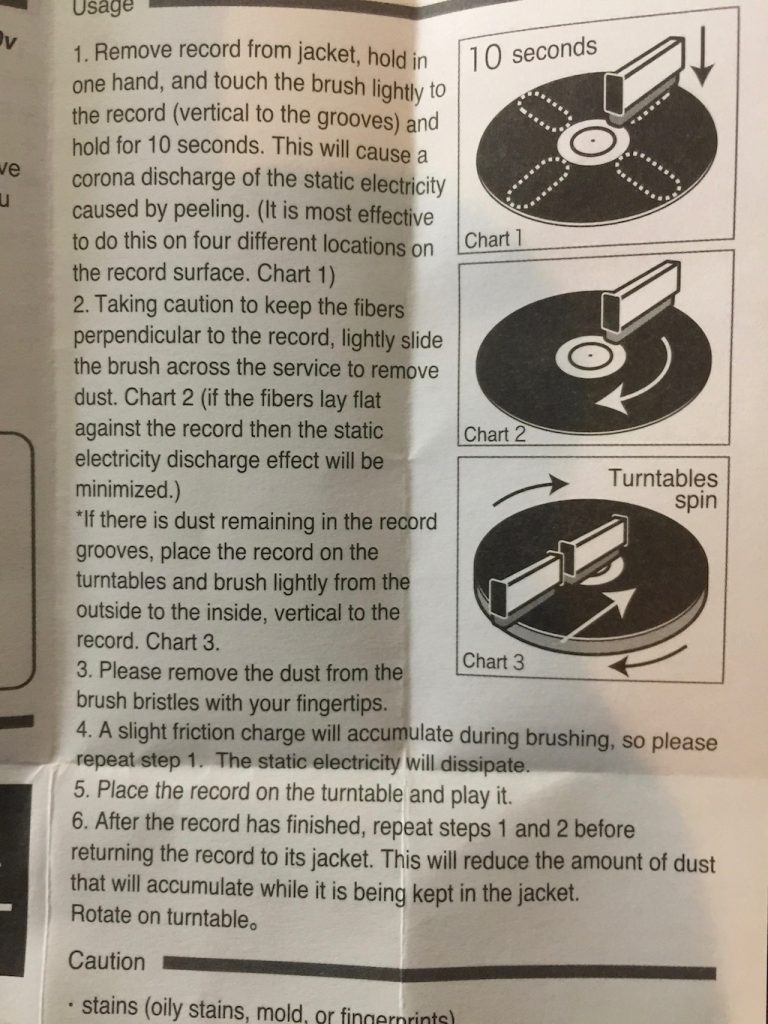The Analog Relax Record Brush

I have had an unhappy relationship with “dry” record brushes over the many years I used them. Such brushes don’t seem to do an effective job of removing surface detritus and despite the “anti-static” moniker applied to some, I have found that dry brushing can generate, rather than mitigate, a static charge. Some also shed fibers. As explained below, I eventually abandoned dry brushing altogether, instead using an “air puffer” to address any surface lint that was introduced after the records had been thoroughly cleaned using a combination of wet cleaning, vacuum and ultrasonic record cleaning.
Background
I cannot remember my first brush, but over the years, I’ve used the Decca (which has been copied many times with less success) and its clones, the Hunt (which consists of a plush pad between two brushes) and various other brushes,[1]none of which, in my estimation, did what was claimed: to remove the lint, dust and other stuff that seemed to accumulate on records out of thin air.[2] At best, most of them would line up the dust particles in one place on the record, but didn’t make it easy to lift the dust from the record surface. I disliked the idea of using a dry brush to push the surface particles across the grooves to one side or the other (outer rim or toward the spindle) to remove them from the playing surface.
None of these products were deep cleaning devices, but instead addressed surface contamination. When wet record vacuum cleaning machines (RCMs) took hold in the States in the early ‘80s,[3]these RCMs addressed the “cleaning” part but didn’t solve the continued attraction of dust to the record surface, post-cleaning. ( See note 2, below). In fact, over enthusiastic vacuuming could add more static and simply exacerbate the problem. So, the need for some form of light surface “dusting” as well as treatment of static still remained, even with the advent of vacuum RCMs. In addition, I have found that a lot of aftermarket inner sleeves seem to shed; I’m now using the MA Records inner, which has a woven, breathable texture and seems to leave less lint.
Between rigorous wet cleaning (including ultrasonic cleaning), control of relative humidity and better record handling, re-sleeving and storage techniques, I have managed to reduce static problems to a minimum.[4]I also play and handle records in bare feet, no shoes or socks, to minimize the charge I create via my body on a carpeted or rug covered floor.
I eventually quit using dry brushes altogether, preferring a Giottos Rocket Blaster air puffer; it does not introduce any additional static charge due to the lack of friction/contact with the record surface. I use that air puffer, holding the record at a tilt, to blow off surface contaminants that collect even on an otherwise thoroughly cleaned record. This approach works once you develop a technique and have minimized static on the records so that the surface lint is easily removed by a blast of air. It essentially avoids any contact between the ‘cleaning device’ and the record surface.
Analog Relax Brush

With that précis, I wanted to try a brush that I heard a “buzz” about on some of the “audiophile” fora––it’s called the Analog Relax and is not distributed in the United States (at least as of this writing). I contacted the manufacturer, Zoot Communications in Tokyo, who graciously agreed to send me a sample to try.
It’s not a fancy brush, made out of posh looking material- in fact, its appearance is somewhat pedestrian, but it seems to be well made. The bundles of fibers are grouped together as shown in the photo below:

According to the accompanying instructions, it utilizes “neutralizing acrylic fibers” supplied by Mitsubishi Rayon. In a tear sheet supplied with the brush, there is a prominent proclamation “NOT CARBON FIBER BRUSH.’ I asked Zoot’s President, Yasushi Yurugi, to provide more detailed information on the brush material:
Although this neutralizing fiber is an acrylic material, there is a
hole in the center of the fiber, and a special material that conducts
electricity is contained in it. So, the conductive material will not
peel off. Carbon material is not used. The fiber material is expensive and is used in LSI assembly and other industrial settings, but is not to my knowledge being offered in brushes for general use due to expense. Your readers should know that the Fiber diameter 0.03 mm, and sufficiently small to get in the groove of the record to remove dust.
I was also curious about the about how the charge was dissipated. I know that Audioquest had introduced a new brush a few years ago (which I have not tried as of this writing) that added a conductive path between the fibers and the handle to help dissipate the charge. According to Yurugi-san, the Analog Relax brush does not use this approach:
The neutralizing fiber is not grounded to the handle of the brush.
This brush is not a system for removing static electricity by energizing the human body. Static electricity can reach very high voltages in industrial settings, and in a factory, could be dangerous. Common sense is not to energize the human body in such factory settings. In this method of neutralizing, the Analog Relax Anti-Static brush performs the discharge from the fiber.
The instructions say you can clean the brush with your fingertips–– I asked Yurugi-san about the effect of any body oils on the brush bristles and was told:
Strictly speaking, skin oil may adhere to the tip of the fiber.
However, the amount was very small, I tested with thousands of
records, but there was no problem with skin oil. However, to customers who dislike using fingers, they could use a soft cloth.
Evaluation
To evaluate the Analog Relax brush, I tried several different records. I had a stack of old copies of Mountain Climbing! that had been cleaned and re-sleeved some time ago. These copies had not been played for a while because I was still trying to find two sides that played without noise––not easy to find if you are familiar with this record. I had cleaned them a couple years ago, inserted them in aftermarket sleeves that later exhibited some shedding and put them to one side until I had the time to listen to these multiple copies and make some comparisons to find the best playing sides. When I examined the records during the course of this piece, several of them exhibited surface detritus, though none seemed to suffer from a pronounced static charge. Nonetheless, the surface lint seemed to cling to the records, suggesting that there was still some charge on them, even if not a pronounced one.
I also used the Analog Relax brush on a couple of records that had been shrink wrapped tightly (rather than poly-bag sealed) and had not gone through any wet clean/vacuum/ultrasonic regime (which typically reduces if not altogether eliminates any static issues) in combination with the other practices I follow (described above).
Technique for Use
Using the brush is a bit different in practice than simply holding it in place as a record whirls on the turntable platter. Instead, you are instructed to place the brush vertically––at a 90 degree angle to the record surface–– and hold it in place for 10 seconds at four intervals around the record:

This helps discharge the static and it seems to work very effectively.
One can then brush the record normally, and the surface dust seems to lift off much more easily, which I assume is a result of no longer being drawn to the record surface by an electrical (static) charge. Since it wasn’t clear to me from the instructions whether the brush ‘hold in place in four spots’ step and brushing was supposed to occur while the record was on the platter or in hand, I sought clarification from Yurugi-san and was told to do these steps holding the record in hand; that follow up brushing, if necessary, could be accomplished once the record was placed on the platter.[5]
Conclusions and Further Thoughts
You may ask why bother to brush at all if my records are already dust-free and I go to great lengths to minimize the static charge in handling them. Fact is, we aren’t working in a clean room environment; I have a dedicated room, no pets allowed, no smoking, etc. and there’s still dust everywhere, no matter how much I clean and vacuum the furniture, rugs and other items in the room. We have a pretty high-grade central HVAC system with appropriate filters, but that’s still not enough. (One can, of course, opt for various ancillary air cleaning systems at some expense). And, unless you have no shedding problems with the inner sleeves, or are able to minimize static in your handling and re-sleeving of the records, you are going to have surface dust issues on your records even if you deep clean using an RCM. Ultrasonic record cleaning does a great job of reducing and eliminating static, but it gets reintroduced through handling and surface dust will reappear as you go through the normal steps of handling and playing a record.
The Giottos Rocket Blaster does a good job of blowing most of the surface detritus off the record. But it doesn’t ameliorate static; instead it simply doesn’t add to it. And there are occasions where the particles are lodged pretty firmly onto the record surface––perhaps static is attracting and holding those–– which aren’t easily ‘blown off” with the Rocket Blaster.
Here’s my thinking on this—even if a record does not exhibit a pronounced charge (which is usually evident in how it clings to the inner sleeve or worse, in crackling sounds plus the very “feel” of a charge when handling the record), it probably has some charge that is inevitable due to handling and un-sleeving/re-sleeving.
By using the Analog Relax brush to first discharge, then brush away the surface dust, you are able to more effectively remove that dust because it is no longer attracted to the record.
I suppose you could achieve a similar result with a Zerostat and a brush—in fact, there is a method to ‘zap’ your brush before using it; I’ve tried that method in the past with mixed results. I do find that the Zerostat is strong mojo—you are countering the charge with another charge that is quite strong. I still have a Zerostat (I’ve had several over the years) but I’ve never loved using it. Pull too fast and it doesn’t work; aiming and releasing requires a little practice (and a reading of the directions helps).
The Analog Relax seems simpler and more passive in how it counteracts the static than shooting ions at the record using the Zerostat. And, with the Zerostat, you still have to brush since zapping alone is not going to remove the surface dust. I think I’ll be more likely to use the Analog Relax brush since it does the work of both–– discharging the static as well as removing the surface dust through the brush action.
My first impressions of this brush are extremely positive, sufficient to get me back to using a brush again after avoiding them altogether for the reasons described above. I obviously have no long-term use experience with the Analog Relax brush but will update my findings as appropriate.
For now, until the company establishes a relationship with a U.S. distributor, you can order the brush directly from Zoot: https://zootcommunication.wixsite.com/analogrelaxshop
Or through Amazon:
https://www.amazon.com/Analog-Relax-AR-ASRB1-Anti-Static-Brush/dp/B00YRINNX2
My thanks to Yurugi-san for supplying a sample of the Analog Relax brush for me to try and for answering my questions.
Bill Hart
Austin, TX
December, 2018
[1]I am excluding the Watts’ Preener and Parastat as well as the original Discwasher since none of them were “dry” brushes but involved the use of humidity or liquid. The Preener had a center core that would be wetted, and the Parastat could similarly be humidified through the use of the Watts Humid Mop, as well as by indirect application of an anti-static fluid to the sponge inside the cover of the Parastat. Likewise, the Discwasher relied on a fluid applied to the leading edge of the applicator. The Watts products are long gone and though the Discwasher was rebooted, I haven’t tried the new version. I did use the Watts products and the original Discwasher in the ‘70s.
[2]That air is filled with dust particles, which are attracted to the record surface through static and the vortex action of the turntable.
[3]Introduced in 1981, the VPI and Nitty Gritty didn’t seem to gain popularity in the States until “used records” became coin of the realm a few years later, in the aftermath of the Death of Vinyl.™ There was, of course, the Monks, which was expensive and less common in the States than in Britain.
[4]I know that some rely on ion guns, like the Milty Zerostat or bench top ionizers. (The latter are available as audiophile products and as industrial devices used in electronics assembly). They work, but I believe in trying to minimize the causes of static in the first place. I also tried various grounding techniques, including the use of a grounding mat near the turntable, with little success. Record handling, including re-sleeving, is likely to introduce a charge through friction. And static isn’t just a devil on its own- it is what seems to attract and hold dust to the record’s surface. So, it is a good idea to minimize it. Many years ago, I also used the Staticmaster anti-static brush that contains a polonium element that periodically needs to be refreshed. I bought a new one several years ago–– it does work, but like the Zerostat, is pretty strong in its effect. Once I have effectively cleaned a record and minimized the charge through the other steps I take, I found it unnecessary (though back in the days before record cleaning machines became common, it was a good tool and is probably still a good alternative for those without access to a wet record cleaning system).
[5]I assume this is due to the fact that the record surface characteristics, and electrical charge, would change when placed on a platter.
Thank you for a really interesting article. I know there are many dry brushes out there (many as you say based on one or two original designs) although I wasn’t aware of this one. It’s nice to see some innovation, even decades after peak vinyl.
Even though the cost of this brush would normally be outside my limited budget (that’s the cost of say 5 ordinary LP’s, depending!) curiosity overcame cost and I ordered one. Hopefully this will be the one and only brush for dry brushing.
Let us know what you think. I know of a few other people who ordered it as well. Thanks for commenting!
bill
Hi Bill, my Analog Relax brush arrived directly from Japan and Ive had a little time to test it. I’m not as impressed as you are with it. Considering it cost me £70 including import duty I don’t think it performs much better than the brush I bought from my local hifi shop in the early 90’s (and similar ones cost about £20 sterling nowadays).
I’ve found that with minor amounts of static and dust it works okay but two LP’s today showed its limitations. I purchased a limited edition London Grammar 2 LP set that was sealed. I had a tug-of-war to get the first LP out of the sleeve due to the static and even though I used the brush as per instructions, there was still static on the LP and it struggled to get the dust off. So much so that under a bright LED light you could see loads of dust had accumulated and I had to use my wet and vac cleaner to sort it.
Similarly the So LP from the Peter Gabriel 25th Anniversary Box set (again new) showed a fair amount of static which the Analog Relax Brush didn’t seem to deal with at all.
I wonder if there’s any clever technique I’m missing?
Greetings, Jolly: Well, that’s disappointing to hear! I have mainly been using the brush after a deep clean on the Monks and/or ultrasonic (KL) so the records were not suffering from a dramatic charge in most instances, but were still littered with surface lint after playing (or sleeving); I did try it on a few still sealed records, pre-deep cleaning and got good results.
No secrets that I know of– the friction from the inner sleeves supplied with new records is often very strong. The techniques I follow, generally, are keeping the relative humidity in the room high (at around 50), handling only in bare feet to minimize any additional static charge and then following the instructions –placing the brush in each quadrant of the record surface and holding it there for ten seconds (4 x 10= X 40). At that point, the charge is supposed to dissipate – then I brush. That has seemed to work for me, but in most cases, I am brushing after wet cleaning (see below).
I can reach out to the company owner for you if you like and see if the manufacturer has anything else to add.
The only other thing I’d offer is to do your wet cleaning first, then do the discharge/brushing as a ‘touch up’ to maintain the record once it has been wet cleaned and dried. (Which is normally how I’d use the brush). Are you able to do the wet clean vacuum without adding static?
Thanks for your reply bill. Yes the wet and vac removed the static / dust and I then put the errant LP’s straight into a Nakaoka anti static sleeve.
I too followed the 40 seconds at cardinal points but maybe I should not wear socks?!
Weirdly, Ive found my old carbon fibre brush, which discharges through the human body, to be excellent for static discharge – works every time. Thats why I was a bit disappointed.
If you think that the manufacturers can shed any additional light on the use (apart from don’t wear socks) then that would be great.
Anyway thanks again for your comments.
The ‘no socks’ thing is something i’ve been doing for ever. Especially with carpeted or rugged floors. But, I already forwarded your first note to the manufacturer to see if he can enlighten. What is your old brush, out of curiosity?
Thanks very much Bill. I can’t tell you the name of the other brush as it was badged by the Hifi shop (who sadly shut down about 10 years ago). It looks similar to some of the slightly more expensive carbon fibre brushes you can buy nowadays and it works pretty well. It certainly seems to deal with static effectively and collects up surface dust quite well.
Maybe I was expecting a static miracle from the Analog Relax as this LP was fiercely charged with static. I didn’t think to compare it to my other brush, I just went straight for the wet n vac cleaner!
Jolly: I received the following last night from Yasushi Yurugi, the President of Zoot Communication, who make the brush:
“I am very sad, as UK users will not experience the effect of the
Analog Relax Anti-Static brush.
The mechanism by which static electricity is generated is very complicated.
The magnitude of static electricity generated by each record differs,
and the humidity of the room strongly influences.
Therefore, depending on the situation I think that the effect of the
Analog Relax Anti-Static brush may not be perfectly experienced.
Please tell him from you, When removing static electricity by the
Analog Relax Anti-Static brush , take a record in his hand.
Because, this method has a high static elimination rate.
When removing electricity while placing records on the turntable,
depending on the material of the turntable sheet, the static
elimination rate may become worse.
I hope that he will experience the effect of the Analog Relax Anti-Static brush.”
Yuguri-San also added:
“As you know, the main material of the record is PVC and carbon, but
various additives are included to increase production efficiency.
And different additives are included depending on the age of record production.
Therefore, static electricity is more likely to be charged in a new
record than in an old record.
Please also tell [your reader] about this factor.”
______
The one thing I would underscore based on both the instructions and my use of it is doing the procedures– of holding the brush in place in 4 places and eventually brushing —while the record is held in your hand, rather than on the turntable platter. I can’t tell in reading your description if that is how you are using it. If not, please try that and report back, OK?